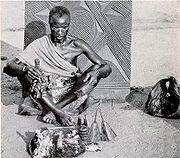- Mmanwu
-
Part of the series on
Odinani
Igbo Mythology and Spirituality

God Almighty
ChukwuDivinities (Alusi)
Ala | Amadioha | Anyanwu | Igwe
Agwu Nsi | Ekwensu | Ikenga | NdebunzeLegendary Creatures & Concepts
Mmuo | Ogu na Ofo
Inouwa | OgbanjeLegendary Figures
Agbala | Eri
Owumiri | MmanwuMmanwu is a traditional masquerade of the Igbo people of southeastern Nigeria. Their culture revolves around work and entertainment, and to the Igbo people, masquerade is a major form of entertainment. The masquerade revolves around their community and masquerades can differ from village to village. Masquerades generally last for a few weeks, however some may span over a few months. These events are frequently performed during the end of the harvesting season and the start of the new planting season. There are some Igbo that perform masquerades throughout the entire year. Masquerades are used to honor the dead and pray to the gods for a successful planting season. Since the Igbo only know their history through oral interpretation, the origins of the masquerade have been lost.
The Igbo masquerades, mmanwu, are traditional performances acted out by exclusive secret societies within a community. These exclusive societies consist of adult male members. Each member must be initiated into the society. Their identity is known only to the other members. The main function of these societies is to celebrate the harvest and to entertain the village people. Some other functions include enforcing village curfews, protection, and as village security guards. The members, also known as masqueraders, wear masks to hide their identity from the rest of the village. The mask is also worn to resemble the spirit of a dead community member. By wearing the mask, a masquerader is thought to have spiritual powers that are conducted through the mask.
The living-dead are what these masquerade/spirits embody. Igbo people believe that the dead never actually die; rather they remain in a "personal immortal state". They reside somewhere between the earthly world and the spiritual world. These living-dead are believed to be closely related to those of the village. Since men are masqueraders, they are buried within their homes so their spirits may be close to their families (Chiene 10). The living-dead then return to the earthly world from time to time to offer spiritual advice. It is the living-dead, who the masquerade portrays.
Types of mmanwu
There are two basic types of masquerades, visible and invisible. The visible masquerades are meant for the public. They often are more entertaining. Masks used offer a visually appeal for their shapes and forms. In these visual masquerades, performances of harassment, music, dance, and parodies are acted out (Oyeneke 25).
The invisible masquerades take place at night. Sound is the main tool for them. The masquerader uses his voice to scream so it may be heard throughout the village. The masks used are usually fierce looking and their interpretation is only fully understood by the society’s members. These invisible masquerades call upon a silent village to strike fear in the hearts of those not initiated into their society.
The invisible masquerades can be broken down into three groups, achikwu ocha/ojii, agu mmuo, and ogbagu. The achikwu ocha (white) masquerade acts as village surveillance. The "entertainment" activities include "singing, joking, and dancing" (Oyeneke 22). Achikwu ojii (black) is the other side of the achikwu ocha masquerade. This is performed not only to protect the village, but also when there is going to be a punishment or execution of a criminal. The second group of invisible masquerades is agu mmuno (tiger spirit). In these masquerades, horrible screaming sounds are produced to create fear. The third group is ogbagu. It is "strictly used for dance entertainment" (Oyeneke 22).
References
- Chiene, Gabriel. Mmanwu Festival: Masquerade as an Entertainer. Anambra State: Ministry of Information, 1990.
- Obuh, Sulvanus Onwukaike Stanley. The Theatrical Use of Masks in Igbo Areas of Nigeria. Ann Arbor: University Microfilms International, 1984.
- Onyeneke, Augustine. The Dead Among The Living: Masquerades in Igbo Society. Province of Nigeria: Holy Ghost Congregation, 1987.
- Perani, Judith and Fred T. Smith. The Visual Arts of Africa. Upper Saddle River: Prentice Hall, 1998.
External links
Categories:
Wikimedia Foundation. 2010.
